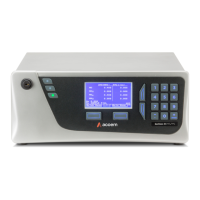5.7.1 Single Point NO
2
to NO Converter Efficiency Check
This procedure is a simple check to ensure the NO
2
converter efficiency for the both the NO
X
path
and the N
X
path are within limits and have not significantly deteriorated.
Equipment Required
Gas Dilution Calibrator which can perform a Gas Phase Titration (GPT) (such as a Serinus Cal
2000/3000) with ozone.
NO gas cylinder reference standard.
Zero Air Generator.
Loop of tubing (to bypass external converter).
Procedure
1. Bypass the external converter by connecting the Aux In and Aux Out ports on the rear panel of
the instrument with a loop of tubing.
2. Open - Main Menu Calibration Menu.
3. Note down the current values for Conv. Efficiency NO2 and Conv. Efficiency NH3.
4. Edit - Conv. Efficiency NO2 - (change to 100%) - Accept.
5. Edit - Conv. Efficiency NH3 - (change to 100%) - Accept.
6. Supply the instrument with a point of zero air.
7. Allow the instrument to achieve a prolonged, stable measurement response and note down the
NO, NO
2
and
N
X
values for reference only. If you get greater than 3 to 5 ppb you need to
troubleshoot the instrument and calibration system before continuing with this procedure.
8. Supply the instrument with NO span gas at a concentration of 80% of the full-scale monitoring
range of the particular instrument.
9. Allow the instrument to achieve a prolonged, stable measurement response and note down the
NO, NO
2
and N
X
values. Label them as [NO]
ORIG
, [NO
2
]
ORIG
and [N
X
– NO]
ORIG
after you perform the
calculation of N
X
– NO.
10. Without changing the previous span concentration, turn on the O
3
generator in the GPT system,
and react the NO and O
3
to produce NO
2
. The O
3
concentration should be no more than 80% of
the supplied NO concentration; there should still be excess un-reacted NO measured by the
instrument.
11. Allow the instrument to achieve a prolonged, stable measurement response and note down the
NO, NO
2
and
N
X
values. Label them as [NO]
FINAL
, [NO
2
]
FINAL
and [N
X
– NO]
FINAL
(after the user
performs the calculation of N
X
– NO).
12. Use these noted measurements to calculate the converter efficiencies of each coil using Equation
4 and Equation 5.
13. If the converter efficiencies are 96% or greater, the converters are working well, return the
converter efficiencies to their original values. Adjustments to the converter efficiencies should
only be made based on a multipoint check (refer to Sections 5.7.2 for NO
2
converter efficiency
adjustment and Section 5.8.2 for NH
3
converter efficiency adjustment). If either of the converter
efficiencies is less than 96%, the test has failed. The converter may require replacement or try
repeating the test and make sure there are no issues with your calibration system. Ensure there
is no drift in NO span or generated O
3
during the test.

